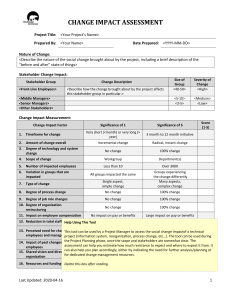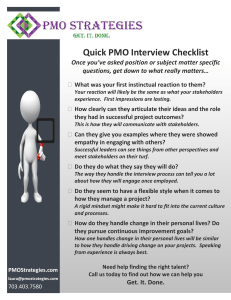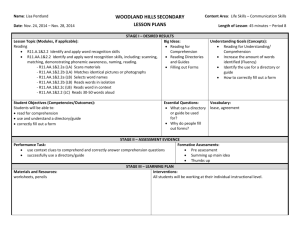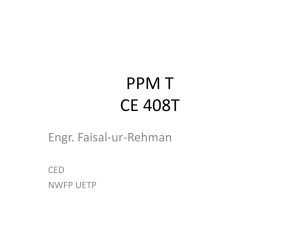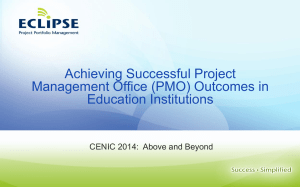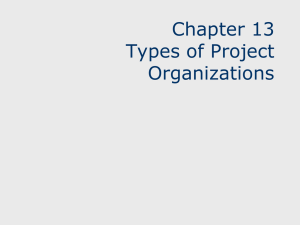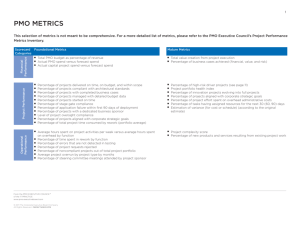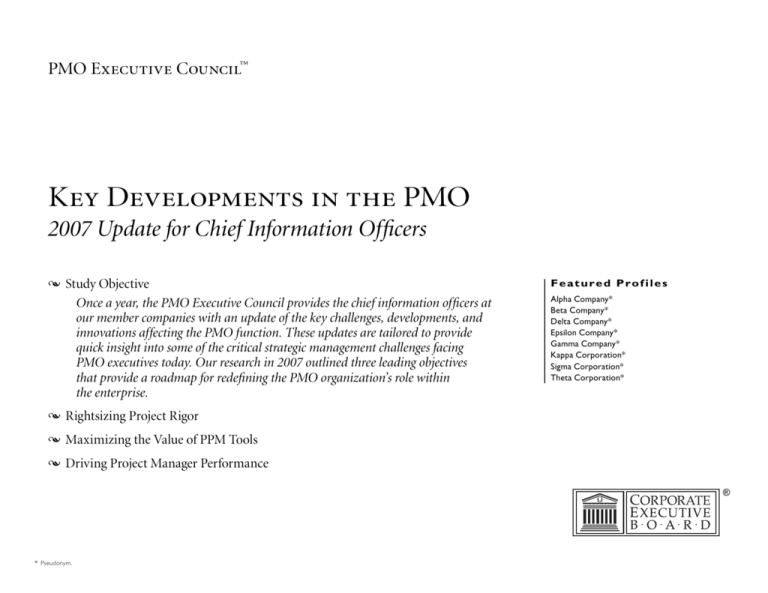
PMO Executive Council™
Key Developments in the PMO
2007 Update for Chief Information Officers
Study Objective
Once a year, the PMO Executive Council provides the chief information officers at
our member companies with an update of the key challenges, developments, and
innovations affecting the PMO function. These updates are tailored to provide
quick insight into some of the critical strategic management challenges facing
PMO executives today. Our research in 2007 outlined three leading objectives
that provide a roadmap for redefining the PMO organization’s role within
the enterprise.
Rightsizing Project Rigor
Maximizing the Value of PPM Tools
Driving Project Manager Performance
* Pseudonym.
Featured Prof iles
Alpha Company*
Beta Company*
Delta Company*
Epsilon Company*
Gamma Company*
Kappa Corporation*
Sigma Corporation*
Theta Corporation*
PMO Executive Council
Creative Solutions Group
Analysts
Amy Davis
Kirk Duplessis
Vivek Swaminathan
Graphic Design Specialist
Todd Burnett
PMO Executive Council
www.pmo.executiveboard.com
Washington, D.C., United States
Telephone: +1-202-777-5000
Fax: +1-202-777-5100
Chicago, United States
Telephone: +1-312-730-9000
Fax: +1-312-730-9100
San Francisco, United States
Telephone: +1-415-293-5825
Fax: +1-415-293-5826
Publications Editor
Andrea Cunningham
Consultants
Pallavi Kapnadak
Kabeh Vaziri
Practice Manager
Matthew McWha
Managing Directors
Jaime Capellá
Wayne Gore
Executive Director
Shvetank Shah
London, United Kingdom
Telephone: +44-(0)20-7632-6000
Fax: +44-(0)20-7632-6001
New Delhi, India
Telephone: +91-124-417-8500
Fax: +91-124-417-8501
Note to Members
Legal Caveat
This project was researched and written to fulfi ll the research requests of several members of the Corporate
Executive Board and as a result may not satisfy the information needs of all member companies. The Corporate
Executive Board encourages members who have additional questions about this topic to contact the Board
staff for further discussion. Descriptions or viewpoints contained herein regarding organizations profi led in
this report do not necessarily reflect the policies or viewpoints of those organizations.
The PMO Executive Council has worked to ensure the accuracy of the information it provides to its members.
This report relies upon data obtained from many sources, however, and the PMO Executive Council cannot
guarantee the accuracy of the information or its analysis in all cases. Furthermore, the PMO Executive Council
is not engaged in rendering legal, accounting, or other professional services. Its reports should not be construed
as professional advice on any particular set of facts or circumstances. Members requiring such services are
advised to consult an appropriate professional. Neither the Corporate Executive Board nor its programs are
responsible for any claims or losses that may arise from a) any errors or omissions in their reports, whether
caused by the PMO Executive Council or its sources, or b) reliance upon any recommendation made by the
PMO Executive Council.
Confidentiality of Findings
This document has been prepared by the Corporate Executive Board for the exclusive use of its members. It
contains valuable proprietary information belonging to the Corporate Executive Board, and each member
should make it available only to those employees who require such access in order to learn from the material
provided herein and who undertake not to disclose it to third parties. In the event that you are unwilling to
assume this confidentiality obligation, please return this document and all copies in your possession promptly
to the Corporate Executive Board.
© 2007 Corporate Executive Board. All Rights Reserved.
PMOEC191GIAH
Table of Contents
Letter to Chief Information Officers
Emerging Challenge: Building the Next Generation of Project Management Capability • 1
Challenge I: Disciplining Project Delivery • 2
Challenge II: Leveraging Project Portfolio Management Tools • 3
Challenge III: Building High-Performance Project Managers • 4
Key Challenges for the PMO Organization in 2007 • 5
Assessing Project Risk • 6
Letter to Chief Information Officers
Once a year, the PMO Executive Council
provides the chief information officers at
our member companies with an update
of the key challenges, developments, and
innovations in the PMO function. These
updates are tailored to provide quick insight
into some of the critical management
challenges facing PMO executives today.
Our research in 2007 defined three principal
initiatives that progressive companies are
pursuing to leverage the full potential
of their PMOs.
A Focus on the Practical
Rightsizing Methodological Rigor • 7
Removing Administrative Burden • 8
Refreshing Metrics • 9
Calculating Capacity • 10
Interviewing for Key Competencies • 11
Defining Project Success • 12
As always, we have focused our work on
providing excerpts of practical, actionable
tools and profiles to enable members to
quickly and efficiently implement the
practices and strategies they find most
relevant to their needs.
We are happy to provide further detail and
discuss the issues addressed in this summary
and are delighted to continue working with
you and your PMO team.
Communicating with Project Sponsors • 13
Matthew McWha
Practice Manager
November 2007
Wayne Gore
Managing Director
Key Developments in the PMO
Emerging Challenge: Building the Next Generation of Project Management Capability
The increasingly projectized corporate work environment is driving demand for project managers to unprecedented levels. At the same time, companies
are placing more accountability for value delivery on the project management function, necessitating development of the next generation of PMO.
Project Manager: Strategic Company Asset
Project managers are the most critical resource
for project success yet remain a scarce skill set…
…as outsourcing does not provide end-to-end solutions
due to criticality of institutional domain knowledge for role…
Strategic Value of Scarce Resources
Project Manager Outsourcing
PMO Executive Council Survey, 2006
PMO Executive Council Survey, 2006
5.0
Project
Manager
Business
Subject-Matter
Expert
Despite outsourcing trends for other
project team skill sets, more than 80%
of project managers are internal staff.
Production
Staff
Average
Strategic
Value to 2.5
Project
Outsourced Project
Manager FTEs
18.2%
IT
Subject-Matter
Expert
In particular, senior project
managers are scarce.
81.8%
0.0
0%
10%
20%
30%
40%
Internal Project
Manager FTEs
50%
Percentage of Respondents Citing as Most Scarce Resource
n = 63.
…underscoring the importance of leadership and business skill gaps
Leader Versus Task Master
Business Partner Savvy
“It’s rare to find a great project manager who is also an effective mentor and
leader. Out of the 75 project managers in my organization, only three of them
embody the true description of leadership. Naturally, they have been labeled high
performers and are destined for the executive level.”
PMO Executive
Fortune 500 Construction Company
“My ‘experienced’ project managers are only experienced for the business unit
they currently serve. Once they are moved to a different LOB, they become junior
project managers all over again. Knowing the business they serve is an essential
tenant of the project manager role.”
PMO Executive
Fortune 500 Retail Company
Source: PMO Executive Council research.
PMOEC191GIAH © 2007 Corporate Executive Board. All Rights Reserved.
1
Key Developments in the PMO
Challenge I: Disciplining Project Delivery
Growth in project demand is continuing to outpace budget growth while projects are becoming larger and more complex. Though the number of projects being
managed is in line with business objectives, the number of successfully delivered projects continues to fall far below expectations.
Still Not Good Enough
Project demand continues to outstrip budget growth…
Funding and Project Volume Growth Estimates for 2007 by Sector
Percentage Increase from 2006
Growth in Project Volume
27%
Budget Growth
10%
7%
16%
16%
15%
14%
7%
13%
4%
11%
10%
9%
10%
4%
(6%)
Cross-Industry
Average
Chemicals
and Energy
Financial
Services
Government and
Public Sector
Health Care
High Tech
Materials
Retail
…amidst high project complexity and lackluster performance
Required Time from
Initial Planning to Completion
Project
Performance
2003–2006
6–12 Months
2–6
Months
7%
14%
Projects That Remain Troubled
(Fail to Meet Expected Budget,
Schedule, Scope, or Quality)
> 1 Year
25%
36%
62%
43%
< 2 Months
Projects
Completed
Successfully
More than one-third of projects take
more than one year to complete.
7%
6%
Projects That
Are Terminated
with Reason
Projects That
Fail Outright
“While we have improved at project execution, our
project success rates are hovering around the 60–70%
range—not where we need to be. We are reexamining
our methodologies to get closer to the 90% range and
get our entire organization more disciplined in the way
projects are executed.”
PMO Executive
Leading Pharmaceutical
Company
Of those surveyed, 38% of projects
did not complete successfully.
n = 109.
PMOEC191GIAH © 2007 Corporate Executive Board. All Rights Reserved.
Toward a 90% Goal
Source: PM Networks, May 2006; The State of Project Management 2006,
Center for Best Practices; PMO Executive Council research.
2
Key Developments in the PMO
Challenge II: Leveraging Project Portfolio Management Tools
In an attempt to drive clarity in an increasingly complex project management environment, many organizations are investing in large, expensive project portfolio
management tools. While these tools promise to ease resource management concerns and optimize project portfolios, these benefits have yet to materialize.
Not Yet Delivering on the Promise
Because project delivery continues to
be a core challenge across the portfolio…
…organizations increasingly adopt commercial
project and portfolio management tools…
Projects Completing on Time and on Budget
Tool Usage
Percentage of Institutions, PMOEC Survey of Heads of PMOs, 2007
Percentage of Institutions, 2006 Versus 2007
March 2006 (n = 74.)
More than one-third of projects
did not complete successfully.
May 2007 (n = 90.)
48%
42%
35%
Organizations using
commercial PPM tools
increased by 16% from
2006 to 2007.
38%
32%
38%
23%
65%
13%
62%
3%
On Time
On Budget
1%
None
n = 53.
Informal
Spreadsheets
Custom-Built
Software
Tool
Commercial
PPM Tool
…only to find that vendor promises are not always delivered in practice
Not a Panacea for Success
“We assumed that purchasing the latest, greatest PPM tool would remedy our process deficiencies,
but one year and $500,000 later, we have the same bad processes and an unused tool.”
PMO Head
Fortune 500 Retail Company
Source: PMO Executive Council research.
PMOEC191GIAH © 2007 Corporate Executive Board. All Rights Reserved.
3
Key Developments in the PMO
Challenge III: Building High-Performance Project Managers
As the economic environment has become more volatile, the project environment has evolved to include more cross-functional, customer-facing initiatives.
Successful project delivery has become more critical to business success than ever before, necessitating the development of high-performing project managers.
A Volatile Portfolio
Increased uncertainty about the economy’s direction…
…leads companies to hedge their funding decisions…
Blue Chip Indicators Growth Forecasts
Top Enterprise Priorities for 2007
2007 U.S. GDP Forecast, January–August 2007
Corporate Executive Board Analysis
Downward
Revision
3.4%
1. Building mechanisms to mitigate risk
of economic downturn
Jan. ’07
2.5%
2. Innovating business models to serve multiple
customer markets
U.S. GDP
Growth
3. Resolving execution challenges in China
2.0%
2006
(Actual)
4. Increasing vigilance in executive compensation
disclosures
Aug. ’07
5. Examining the efficacy of IT investments
2007
(Forecast)
…which, coupled with growing
project complexity and criticality…
…exacerbates uncertainty
and pressure on the PMO
Evolution of Typical Projects
PMOEC Analysis
Not Getting Any Easier
2002
2007
• Single silo
• Back-office processes
• Medium-sized projects
with minimal dependencies
• Cross-silo
• Front-and back-office
process integration
• Larger projects with
complex dependencies
“It’s not just that business is getting more complex, but that the next
layer of opportunities for IT happen to be in a more complex part
of business. It has become more complex to define processes, drive
consensus, develop solutions, and communicate across silos.”
Chief Information Officer
Retail Corporation
Source: “Blue Chip Economic Indicators,” Reuters, 2007; Corporate Executive Board’s State of the
Enterprise: The 2007 Agenda; CIO Executive Board research; PMO Executive Council research.
PMOEC191GIAH © 2007 Corporate Executive Board. All Rights Reserved.
4
Key Developments in the PMO
Profiled below are leading practices the PMO Executive Council has identified over the course of 2007 that best define the evolution of a progressive
PMO organization.
Key Challenges for the PMO Organization in 2007
I.
Disciplining
Project Delivery
II.
Leveraging Project
Portfolio Management Tools
III.
Building High-Performance
Project Managers
Highlighted Practice
Highlighted Practice
Highlighted Practice
*
Close-Ended
Complexity Assessment
Alpha Company determines the appropriate
methodological rigor by using an up-front
complexity filter.
*
Lightweight
Portfolio Visibility
Epsilon Company streamlines data input
requirements to increase returns on
metrics gathering activities.
Case Examples
*
*
MethodologyTailoring Directives
Case Examples
*
Kappa Corporation uses real-life case
studies to screen project manager
candidates.
Case Examples
*
Theta*
* Pseudonym.
5
*
Competency-Based
Case Interviews
Tool-Informed
Demand Management
Project Manager
Time Reallocation
PMOEC191GIAH © 2007 Corporate Executive Board. All Rights Reserved.
Kappa Corporation
Success-Aligned
Incentives
Informed Stakeholder
Communication
Management
Key Developments in the PMO
Assessing Project Risk
Alpha Company* conducts an up-front complexity assessment of all projects, in addition to the standard size assessment, allowing it to drive greater
visibility into possible project delivery risks and assign a project methodology suitable to the needs of the project.
Look Beyond Project Size
Alpha Company accurately measures project delivery risk through close-ended questions and clear criteria
Project Size
Criteria
Project Complexity
Small
Medium
Large
Criteria
< 24
24–170
> 170
< $500
$500–$1,000
> $1,000
1. Requirements
Complexity
3. Elapsed Project Duration (Months)
<4
5–12
> 12
4. Project Team Size
<4
5–15
> 15
1. Work Months
2. Budget
Low
Intermediate
High
Straightforward
and well
understood by
project team
Complex and well
understood by
project team
Complex and not
well articulated
2. Number of Projects
Impacted
0
1
>2
3. Interfaces to Existing
Systems
0
1–3
> 3 or external
4. Internal and External
Groups to Coordinate
1
2–4
>4
N/A or batch
processing only
Simple online
query and update
Complex
processing—
Internet and
distributed systems
N/A or < 50
entities
50–100 entities
> 100 entities
7. Online Response
Time
> 7 seconds
3–7 seconds
< 2 seconds
8. System Availability
N/A or < 95%
98%
> 99%
9. Number of Daily
Transactions
< 1,000
1,000–50,000
> 50,000
< 30 days outage
tolerable
1 week outage
tolerable
1 day outage
tolerable
N/A, good
quality, simple
to convert or
automatable
Fair complexity,
average
complexity,
average to convert
Poor quality, very
complex, difficult
to convert
5. Processing Type
Complexity Matters
6. Data Complexity
“If projects are categorized only by size, you overlook the risk of
smaller, more complex projects that can have an impact on multiple
systems or multiple business units.”
Senior Manager, IT Best Practices
Alpha Company
10. Business Criticality
11. Data Quality
and Conversion
* Pseudonym.
PMOEC191GIAH © 2007 Corporate Executive Board. All Rights Reserved.
Source: Alpha Company; PMO Executive Council research.
6
Key Developments in the PMO
Rightsizing Methodological Rigor
During the project scoping phase, Beta Company* uses a simple, six-question suitability filter to determine whether
a project should follow the light or full methodology. A workshop is then held to specifically tailor the project delivery methodology.
Seeking Clearance for Takeoff
A suitability filter helps project
managers choose a methodology track…
…and appropriate deliverables
are selected in a focused meeting…
Light Methodology Suitability Filter
Methodology Rightsizing Workshop
Statement
The project does not require a feasibility study (e.g., it is a tried and tested solution).
Yes
Participants
No
All responses
must be “Yes”
to approve
use of light
methodology.
The project is using existing technology, environments, and systems.
The project will only make changes to an existing application
and will not make fundamental changes to the system.
The project will be delivered in a single implementation.
Design Authority
Representative
Program
Manager
Project
Manager
Architect
The project does not involve implementing a new third-party package solution.
Finance
Manager
The project is being delivered solely for Beta Company’s use and benefit.
Business
Analyst
…with project managers obtaining sign-off to exclude waiverable deliverables to create a formal management plan
Terms of Reference
A
Deliverable
Application Owner
Service Management
Manager
Applications Service
Manager
Gateway Manager
Project A
Project A
Project A
Management Plan
Program Manager:
Accountable Project Manager:
A
A
Operability Checklist
Signature:
Design Manager
Project Authority
Project: Web Site Interface
Update
Project Manager: John Smith
Deliverable: System
Infrastructure Definition
Approver: John Finn
Executive Sponsor
Deliverable Waiver
Completed Date
Excluded Deliverable
Project Management Deliverables RACI Chart
Service-Level Agreement
I
R
R
Implementation on Readiness
Review
I
A
I
User Acceptance Specifications
C
A
A
R
A
* Pseudonym.
PMOEC191GIAH © 2007 Corporate Executive Board. All Rights Reserved.
This document
serves as the final
methodology
roadmap for the
project.
Reviewer
C
Contribute
Approve
I
Inform
Source: Beta Company; PMO Executive Council research.
7
Key Developments in the PMO
Removing Administrative Burden
Delta Company* introduces the project planner role to ease the administrative burdens of project managers. Project planners support project
managers by taking on activities such as project scheduling and planning, PPM tool updates, ad hoc metrics and reports production, and tagging and
formatting resources to ensure up-to-date information.
Off-Loading Administrative Activities
Delta Company uses a small number
of multifunctional project planners…
…to improve consistency across the
entire project management community…
Description of Role
Multiplier Effect
1
Illustrative
Project
Scheduling
and Planning
Projects
Project Managers
2
Project
Updates
in PPM Tool
Project
Planner
3
Ad Hoc
Metrics
Generation
4
Tagging and
Formatting
of Resources
Seven project planners assist
70 project managers in
handling 140 projects.
…leading to a 15% increase in time available for external stakeholder management
Project Manager Time Allocation
External Responsibilities
• Stakeholder Management
• Vendor Management
Internal Responsibilities
• Risk Planning
• Resource Allocation
• Communication Planning
• Issue Management
• Day-to-Day Management
Before Planners
External
Project Manager Time Allocation
Planners provide support with risk
planning, resource allocation, and
communication planning.
After Planners
External
30%
45%
56%
Internal
51%
14%
Internal
Administration
4%
* Pseudonym.
PMOEC191GIAH © 2007 Corporate Executive Board. All Rights Reserved.
Positive Externalities
• Data Consistency
• Common Terminology
• Immediate Communication
• Early-Risk Identification
Administration
8
Source: Delta Company; PMO
Executive Council research.
Key Developments in the PMO
Refreshing Metrics
Epsilon Company* applies metrics discipline by reevaluating data collection on a quarterly basis. Specifically, they restrict metrics collection
to those metrics that are currently used while new metrics are introduced only as needed.
Measures That Matter
Epsilon Company revisits its metrics on a quarterly basis to ensure ongoing applicability
Metrics Decision Rules
Do we currently track this metric?
Yes
No
Actionable
• Does it provide actionable data?
• Have we utilized this data for specific decisions?
Yes
Retain Metric
Decision Enabling
Does the metric translate technical project data into
business risk implications that executives can leverage
for mitigation trade-off decisions?
No
Yes
Predictive
Does the metric provide directional guidance
on readiness to meet future threat scenarios?
Drop Metric
Yes
Adopt Metric
Consider alternative metrics that provide a contextual
framework for metrics to facilitate short- and long-term
trend identification.
No
Discard unless the metric serves a specific and useful purpose.
* Pseudonym.
PMOEC191GIAH © 2007 Corporate Executive Board. All Rights Reserved.
Consider replacing metric with one that highlights
“early-warning symptoms” along with specific types
of risks to forewarn management of potential negative
outcomes to be mitigated.
No
Modular
Does the metric have features that can be integrated
with other metrics to synthesize overall project,
portfolio, and PMO performance?
Yes
Revisit reasons for considering metric to determine its
decision-enabling characteristics. Start by understanding
specific needs of different audiences and their
information requirements.
No
Comparable Over Time
Does the metric capture historical trends in
performance?
Yes
No
Source: Epsilon Company; PMO Executive Council research.
9
Key Developments in the PMO
Calculating Capacity
By outlining the value of individual projects, Gamma Company* gets a deeper understanding of how to prioritize strategic projects. The activity
value matrix presents a uniform method to evaluate projects using a consistent set of criteria. Skill-based resource requirements are incorporated into
this procedure to match supply of resources with the portfolio.
Window into the Future
Gamma Company considers operational realities…
Activity Value Matrix
Investor Map
Items
Total Prioritization—Estimated Total($): $$$$
Activity Level
of Effort
Activity
Benefit 1
Benefit 2
Benefit 3
Benefit 4
Benefit 5
Sum
$$$$
$$$$
$$$$
$$$$
$$$$
Current Year Potential
Future Year Planned
Metric
Maturity Level
Strategy 1
Strategy 3
Strategy 2
Strategy 4
Regulatory
Infrastructure
Product Capabilities
Customer Experience
Transformation
Strategy 5
Strategy (Circle One)
Activity Name:
Project Type (Circle One)
Business Model/Process Transformation
Technology Impact
Yes
Cumulative 30
Score
No
Business Capability
Value Description
The value of each activity is described to driving
understanding individual projects and how well
they align to strategy. Resourcing is informed
using high-level, role-based estimates.
-10
No Scoring
Data Available
Not Recommended
Current Year Planned
Actual Bucket
Color by: Level of Effort Indicator
Size by: Prioritization—Estimated Total($)
…to determine project candidate selection, prioritization, and initiative spend
Portfolio plans
are charted for
current and future
project needs.
Multiyear plans
alleviate resource
issues up front.
Decisions
• Project Selection
• Portfolio Prioritization
• Initiative Spend
Activity Value Matrix + Investor Map =
What-If Scenario Plans in ProSight
Strategic Project Governance Team,
Consisting of Senior-Level VPs and Managers
* Pseudonym.
PMOEC191GIAH © 2007 Corporate Executive Board. All Rights Reserved.
Source: Gamma Company; PMO Executive Council research.
10
Key Developments in the PMO
Interviewing for Key Competencies
Kappa Corporation
To assess a project manager candidate’s proficiency in critical competencies, Kappa Corporation* incorporates case-based, behavioral
interviews into the hiring process. These case interviews are based on real-life projects delivered by their organization and are designed
to highlight the most important skills for successful project management at Kappa.
Round Peg, Round Hole
PMO identifies new-hire competency requirements…
…and develops a corresponding interview
guide based on recent project scenarios…
Critical Competencies Required
Partial List
Case Interview Guide
Evaluation Approach
Scenario: Critical resource conflict
Problem Solving
Business Judgment
Ownership and Accountability
Influencing Skills
Your project is two weeks away from beginning testing.
While confirming resource assignments, you discover a
conflict. The testing resource assigned to your project
is working on a different project that has now made him
unavailable for eight weeks. This is the only testing resource
in the organization that has the skills required to complete
testing for your project. What do you do?
• Poise with Executive Audience
• Ability to Inspire Trust
• Verbal Communication
Observe
During Interview
Questions
Scenario criteria
include the following:
• Based on recent,
mission-critical project
• Encompass “tough call”
situation
• Require broad skill-set
to manage
Case Project: External Web Site Security
Authorization Upgrade
Competencies
•
Via Case- and Behavior•
Based Interview Questions •
•
Assess
1
…to appraise candidates proficiency level and cultural fit for project environment
360-Degree Candidate Interview
Candidate Evaluation
2
Each case interview
is followed up with a
series of behavior-based
questions to further
assess candidate’s
experience and
proficiency.
Illustrative
Fails to Meet
3
Meets
Exceeds
?
PM Candidate
Manager and peerlevel participation
generates buy-in for
hiring decisions and
provides a litmus test
of candidate fit to
current environment
and team dynamics.
Partially Meets
Problem Solving
Business Judgment
Ownership and Accountability
Influencing Skills
Internal
Customer
Representative
Hiring
Portfolio
Manager
EPMO
Representative
(Peer Level)
Poise with Executive Audience
Ability to Inspire Trust
Verbal Communication
* Pseudonym.
PMOEC191GIAH © 2007 Corporate Executive Board. All Rights Reserved.
Source: Kappa Corporation; PMO Executive Council research.
11
Key Developments in the PMO
Defining Project Success
To reinforce a sense of ownership and commitment to full project outcomes, Sigma Corporation* employs a practice to define “success”
for both the project and the individual project manager role. At the beginning of a project at Sigma Corporation, the project manager
facilitates an up-front agreement on the definition of success key with project stakeholders, which is backed up by clear, quantifiable, and measurable metrics.
Beginning with the End in Mind
The business sponsor, project manager, and project
stakeholders define success for each project up front…
…setting realistic expectations for
project success in the project charter
2
•
•
•
•
Project Stakeholder Priorities
Updating customer operations protocols
Establishing monitoring and controls
Standardizing infrastructure requirements
Adhering to architecture and development
standards
Priority levels indicate
relative importance of
success dimensions.
1
Project-specific charter
outlines consensus-driven
definition of success.
Project Success Matrix
Illustrative
•
•
•
•
•
Project Manager Priorities
Setting and facilitating realistic success
measures
Providing a voice of experience
Facilitating trade-off negotiations
Ensuring alignment to strategic objectives
Surfacing program-level interdependencies
(with assistance from program managers)
•
•
•
•
•
Project Sponsor Priorities
Driving value realization
Improving service-level agreements
Ensuring customer satisfaction
Boosting revenue
Approving final sign-off on success measures
Parameter
Description
Objective
Priority
Acceptable Variance
Schedule
Planned versus actual completion date
40 Weeks
2
+/– 5%
Cost
Planned versus actual cost
$2.4 Million
3
+/– 5%
Business Value
Incremental annualized revenue 6 months after release
$1.5 Million
1
+/– 5%
Quality
Post-release patches 90 days after deployment
2
5
+/– 50%
Application
Response Time
Average user response time for North America
2 Milliseconds
4
+/– 10%
Customer Support
Reduction in level 1 technical support calls
10%
6
+/– 20%
Service-Level
Agreements
Web site uptime goal
99%
7
+/– 30%
3
Clearly defined variances serve as
guardrails for in-flight decisions.
* Pseudonym.
PMOEC191GIAH © 2007 Corporate Executive Board. All Rights Reserved.
Source: Sigma Corporation; PMO Executive Council research.
12
Key Developments in the PMO
Communicating with Project Sponsors
Theta
To equip project managers with effective tools to better inform their ongoing communication with project stakeholders, the Theta Corporation*
PMO leverages analysis and segmentation of stakeholders to drive project manager stakeholder communication strategies.
Mapping the Stakeholder Terrain
Formal assessment helps project managers prioritize efforts
for customized stakeholder management strategy and communication
Stakeholder Assessment
Illustrative
Project: SAP Financials Implementation
Name: Francisco Santos
3
Stakeholders are classified
into priority segments
to tailor communication
strategies accordingly.
Department: Internet Business Solutions Group
Title: Senior Consultant, Operations
Supplier
Supportive
Project Sponsor
Developer
Neutral
Customer
Sponsor’s Boss
Resistant
Financier
Auditor
Super User
Other: ___________
Supportive
Change
Posture
Neutral
Make or Break
Executive Sponsor
Segmentation Matrix
Influential
Deliberate effort to
identify point of view
facilitates understanding
of how project will
impact stakeholder.
Change Posture
Impacted
1
Priority
Segmentation
Type of Stakeholder
Resistant
Low
Medium
High
Degree of Influence
User
2
Recognizing primary
influencers aids
development of
communication tactics
to improve or maintain
change posture.
Personalized
Communication
4
Motivations and Incentives
• Reduce administrative burden
• Recognition of consecutive project success
to aid 2008 promotion opportunity
• Boost employee morale
across department
Primary Influencers
• Laura Shah, Director,
Operations
• Deborah Goldstein,
Team Manager, Customer
Service
Weekly update e-mail
Trigger-based phone call
Weekly update phone call
Trigger-based e-mail
Standing in-person meeting
Ongoing e-mail CC
Assessments are
for internal project
manager community
use only and are shared
across project teams.
Strictly Confidential
* Pseudonym.
PMOEC191GIAH © 2007 Corporate Executive Board. All Rights Reserved.
Communication Preferences
Source: Theta Corporation; PMO Executive Council research.
13
PMO Executive Council
Washington, D.C. • Chicago • San Francisco • London • New Delhi
w w w.pmo.executiveboard.com
PMOEC191GIAH

